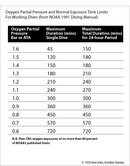I thought that I would share a first hand experience of an oxygen toxicty event, so that someone may benefit.
Several years ago, I was doing a decompression dive to 180 feet on x17/20 (17% oxygen, 20% helium). On ascending to 110 feet (1.4), I switched to my low o2 deco gas which was x32. I was very slightly negative on the ascent and was about to kick gently up to the first decompression stop. Shortly after switching to the x32, I had some minor issue that I wanted to resolve. While solving the problem, suddenly, I saw fireworks in front of my eyes (visual disturbance, oxygen toxicity symptom), saw that I was at 130 something (1.6), and immediate switched back to the x17/20. Within a few seconds, the visual disturbance went away and I resumed the ascent after staying on the x17/20 for several minutes.
What happened was, as I was solving the minor problem, I had stopped kicking and was actually, very slowly descending. In addition to the fireworks, I recall being very agitated at the time (irritability another CNS toxicity symptom).
I routinely do 1.6 ata for deco and was actually surprised that this had happened. I attribute the increased sensitivity to the activity that I was undergoing to resolve the minor problem.
Please be familiar with the VENTID symptons. There is no guarantee that you will have a symptom or that you will recognize it if it does occur. But, if you do know the symptoms and you do have a sympton, you might at least know what is going on and ascend enough to recover. I was fortunate enough to have the x17/20 and to be familiar with the symptoms and also to have a symptom prior to a CNS convulsion.





